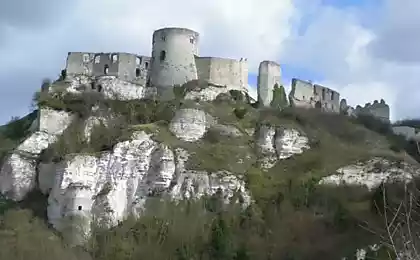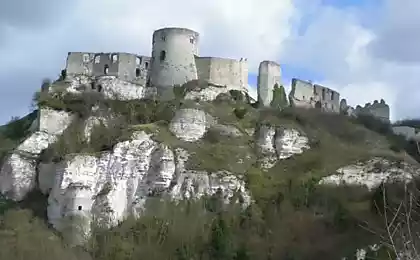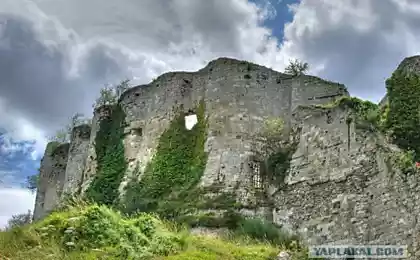979
10 mysteries of archeology that we may never reveal
Archaeologists - strange people. They are ready to go for months in the godforsaken corners of our planet, to thoroughly dig into the ground ...
I must say, among the debris of modern scientists sometimes find really interesting objects, but often these findings give rise to more questions than answers. To understand an abiding passion for archeology endless race for the last of humanity, it is necessary to go to the excavations and the long hours of work with a shovel in the hope to make an archaeological sensation ...
Or read this collection Website - there you will find ten mysteries of modern archeology, which is waiting to Schliemann and Champollion.
1. "Candelabrum Paracas» h2> Many of you have probably heard about the Nazca Lines - huge cave paintings located in southern Peru, but few know that in the same desert of Nazca, about 200 km from the geoglyphs, there is another mysterious object over which the destination for many years, archaeologists scratching their heads.
2. "Uffington White Horse» h2> Stonehenge - not the only archaeological site in good old England, though, when it comes to the antiquities of Albion, in the first place is always remember about him.
3. "The Book of the Zagreb mummy» h2> «Zagreb linen book" is known as the longest text in Etruscan language from the extant written records of this great culture. Adverb Etruscans had a marked influence on the formation of the Latin, but unfortunately, related to the Etruscan language does not currently exist, in addition, has reached us so few documents of the era, which is fully decipher the text "Books" is not possible - scientists were able to convert only some its fragments. From the well-known at the moment of detention, "the Book of the Zagreb mummy" (another name for the artifact), it can be concluded that the document is a ritual calendar that describes the intricacies of the religious traditions of the Etruscans.
4. "Rock the White Shaman» h2> Archaeologists and historians for many decades studying the artifacts of the peoples of North and South America, but until now the culture pre-Columbian American history in many ways remains a mystery to experts.
5. Geoglyphs Mountains Sayama h2> Rock carvings found in Bolivia, one of the slopes of Sayama, technique of creating remind Nazca Lines and the "Paracas Candelabra" - they, too, are carved into solid rock, with the Bolivian figures much more Peruvian - Image occupied an area of about 7, 5 thousand m² (15 times more than the Nazca Lines), the length of some of the lines that make up the objects Sayama, has about 18 km.
6. Artifacts Terterii h2> Three stone tablets that have been found by scientists in the vicinity of the Romanian village Terteriya, contains characters that are now the oldest written language in the world.
7. Blythe Intaglios h2> This archaeological site, located in the southern California desert in Colorado, near the town of Blythe, a giant geometric shapes, and images of animals and people
8. The death of Alexander the Great h2> Alexander the Great - one of the most famous historical characters, the life of the great commander devoted thousands of scientific and artistic books, hundreds of movies, but the reason for his death is now almost nothing is known.
9. Minaret of Jam h2> Minaret of Jam is located in north-western Afghanistan, was built at the turn of XII-th and XIII-th century, but its perfect design, stunning decor and the skill of medieval Afghan builders still surprised all who had the opportunity to witness This architectural masterpiece of fired brick.
10. "The Emerald Tablet» h2> Unlike other archaeological phenomena compilation, "The Emerald Tablet" has not survived to our time, so that the scientists do not know who was the author of the original of the document for which it was intended and what fate befell the monument of medieval Eastern Art.
I must say, among the debris of modern scientists sometimes find really interesting objects, but often these findings give rise to more questions than answers. To understand an abiding passion for archeology endless race for the last of humanity, it is necessary to go to the excavations and the long hours of work with a shovel in the hope to make an archaeological sensation ...
Or read this collection Website - there you will find ten mysteries of modern archeology, which is waiting to Schliemann and Champollion.
1. "Candelabrum Paracas» h2> Many of you have probably heard about the Nazca Lines - huge cave paintings located in southern Peru, but few know that in the same desert of Nazca, about 200 km from the geoglyphs, there is another mysterious object over which the destination for many years, archaeologists scratching their heads.
«candelabrum Paracas" (or "Paracas Candelabra») has enormous dimensions: 128 meters in length and 74 in width, and thickness of the line is 4 m. Despite the fact that it is located near the Nazca lines, experts We convinced that the creators of the geoglyphs have any relation to it. Found during excavations in the area of "Candelabrum" artifacts suggest that the image created about 200-m BC, according to some, Nazca Lines appeared on 600-800 years later. The similarity of the art image alludes to the fact that the culture of Nazca is the successor of the Paracas culture, which belongs to the "chandelier».
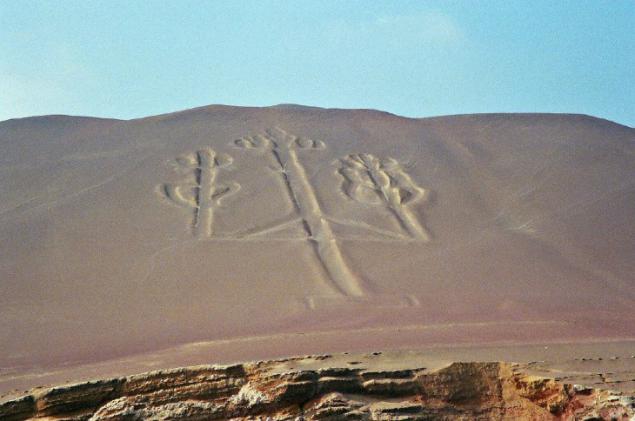
Scientists more or less clear, when there was a "Paracas Candelabra" and who created it, but the purpose of the ancient painters is unclear. Some archaeologists believe that the object is a shrine of the creator god Viracocha, worshiped by the local tribes, others have suggested that the image served as a landmark for ancient seafarers - the huge size "chandelier" carved into the hillside, so it is perfectly visible from the ocean, with a distance of about 20 km.
2. "Uffington White Horse» h2> Stonehenge - not the only archaeological site in good old England, though, when it comes to the antiquities of Albion, in the first place is always remember about him.
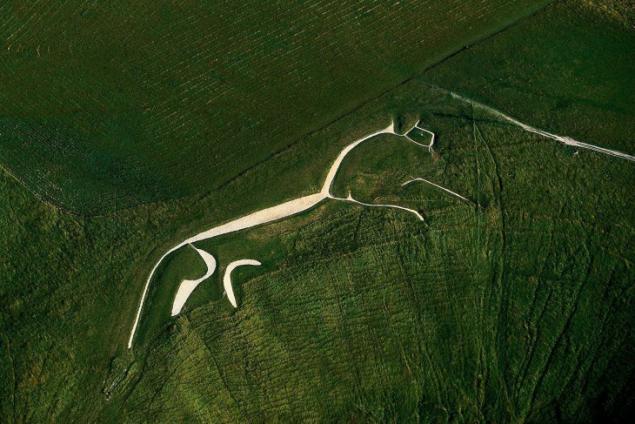
above the giant stylized figure of a horse, located near the village of Uffington, on the territory of modern Oxfordshire, ancient sculptors had to work hard - line drawings are deep trenches filled with crushed chalk, and the length is up to 115 m. Imagine imagine how much effort the creators of "Horses" should adorn the hill this installation, because they did not have excavators, bulldozers and other technical devices, which boast modern builders.
Figure is similar to images of horses, found on the coins of the Bronze Age, beside him, archaeologists discovered the burial, presumably appeared in the Neolithic period. Scientists are not yet able to reach consensus on the establishment of the "White Horse" - many of them claim that the object of the Bronze Age geoglyphs too well kept, but others point to the fact that the locals since ancient times carefully monitor the state of "Horses" and every few years "update" drawing - this explains its almost original form.
3. "The Book of the Zagreb mummy» h2> «Zagreb linen book" is known as the longest text in Etruscan language from the extant written records of this great culture. Adverb Etruscans had a marked influence on the formation of the Latin, but unfortunately, related to the Etruscan language does not currently exist, in addition, has reached us so few documents of the era, which is fully decipher the text "Books" is not possible - scientists were able to convert only some its fragments. From the well-known at the moment of detention, "the Book of the Zagreb mummy" (another name for the artifact), it can be concluded that the document is a ritual calendar that describes the intricacies of the religious traditions of the Etruscans.
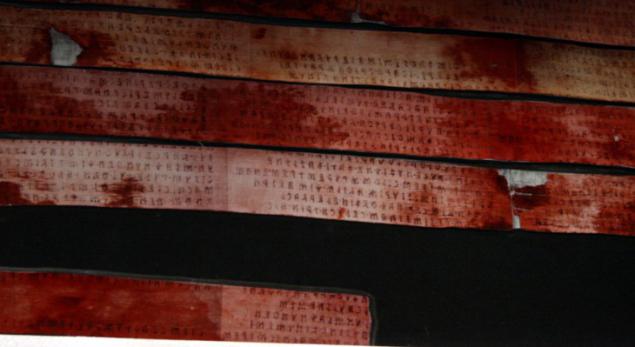
The book is dated III-th century BC, so the very fact of its existence is unique - the manuscript, made of fabric, ruthless time, usually destroys much earlier. One of the reasons why the monument of Etruscan culture is now available for the study, considered that the book material was used to wrap an Egyptian mummies
4. "Rock the White Shaman» h2> Archaeologists and historians for many decades studying the artifacts of the peoples of North and South America, but until now the culture pre-Columbian American history in many ways remains a mystery to experts.

«White Rock Shaman», located near the Pecos River in present-day Texas, ranked among the most famous and at the same time - the most mysterious monuments of the era. According to scientists, a huge (about 7 m in length) drawing appeared more than 4 thousand years ago and belongs to the ancient culture, which is now virtually nothing is known. Some archaeologists believe that the art object shows a fight scene or any ritual combat, and it is believed that the artist showed the moment of communication with the spirits of the ancient means of mescaline, a psychotropic substance contained in the peyote cactus.
5. Geoglyphs Mountains Sayama h2> Rock carvings found in Bolivia, one of the slopes of Sayama, technique of creating remind Nazca Lines and the "Paracas Candelabra" - they, too, are carved into solid rock, with the Bolivian figures much more Peruvian - Image occupied an area of about 7, 5 thousand m² (15 times more than the Nazca Lines), the length of some of the lines that make up the objects Sayama, has about 18 km.
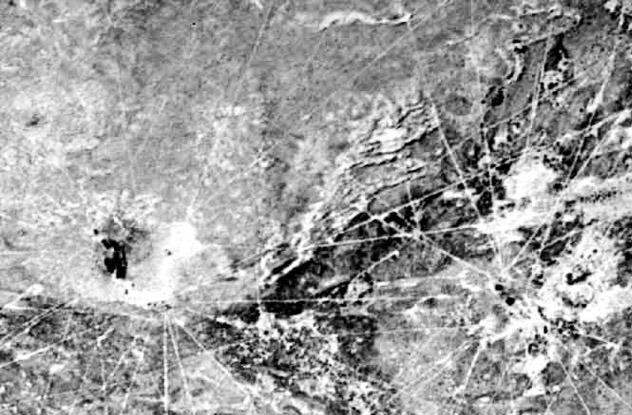
With such outstanding amounts, geoglyphs Mountains Sayama still little studied - the true extent of the work done by the ancient artists became known recently that archaeologists have the opportunity to use satellite imagery in their research area. Amazing accuracy and accurate line drawing specialists put to a standstill - they seem drawn with a ruler. Purpose images also remains unclear, according to some assumptions, the ancient inhabitants of Bolivia, with their help made astronomical calculations, moreover, the pattern may be a form of ritual burial.
6. Artifacts Terterii h2> Three stone tablets that have been found by scientists in the vicinity of the Romanian village Terteriya, contains characters that are now the oldest written language in the world.
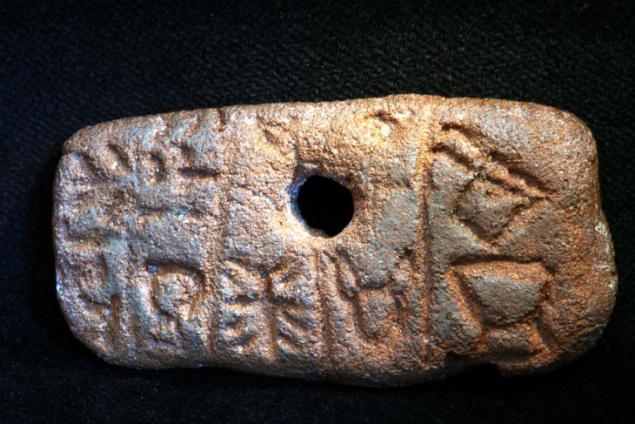
Originally, scientists assumed that the signs are dated Terterii the third millennium BC, but more thorough radiocarbon analysis revealed that much older artifacts. Now, most archaeologists agree that the plates are created about 7, 5 thousand years ago, long before the Sumerian writing, which was previously considered the oldest in the world. Rather, the findings of Romanian archaeologists belong to the pre-Indo culture of Vinca, which was extended to the territory of modern South-Eastern Europe in the Neolithic period, as symbols on the labels are very similar to the icon depicted on the found in 1875 near the Serbian town of Vinca remains of ancient ceramics.
7. Blythe Intaglios h2> This archaeological site, located in the southern California desert in Colorado, near the town of Blythe, a giant geometric shapes, and images of animals and people

Archaeologists can not agree on the age of geoglyphs - called the numbers from 450 to 2 thousand years old, it is also unclear what exactly is depicted in the drawings. According to one of the most common versions huge figures created ancestors of Indian tribes and the Mojave kvechan, currently living in the lower reaches of the Colorado River. According to the legends of indigenous people of this region, in the form of human figures depicted various artists Mastambo incarnation of God, the Creator of all things, and they painted animals - not that other, as zverochelovek Hatakulya directly involved in the creation of the world.
8. The death of Alexander the Great h2> Alexander the Great - one of the most famous historical characters, the life of the great commander devoted thousands of scientific and artistic books, hundreds of movies, but the reason for his death is now almost nothing is known.

Most historians agree adopted in orthodox scientific community point of view on the time and place of Alexander's death - 10 June 323rd BC, the palace of Nebuchadnezzar II-nd in Babylon, but what killed most ambitious conqueror in history - a convincing answer to this question there is still no.
For a long time it was thought that Alexander was poisoned, and in the suspects visited almost all the members of his entourage - from generals to lovers of exceptional historical figure. Version poisoning is based on the testimony of his contemporaries, who claim that the invincible Alexander suddenly struck an unknown disease, about two weeks he spent, suffering severe abdominal pain, and then died. This information should not be considered conclusive evidence of poisoning commander, as these symptoms may indicate pancreatitis, hepatitis, endocarditis, or any infectious disease, such as typhoid fever or malaria. When the then level of development of medicine, any of these illnesses could be fatal for Alexander.
Surprisingly, the death of Alexander was predicted Chaldeans , who lived in Babylon - they warned the commander that he would die soon after will enter into Babylon, in addition, the copepods, one of the scientists who accompanied the invading army, dying , told Alexander that when his army conquered Babylon, they will meet again. So do not believe after that forecasters.
9. Minaret of Jam h2> Minaret of Jam is located in north-western Afghanistan, was built at the turn of XII-th and XIII-th century, but its perfect design, stunning decor and the skill of medieval Afghan builders still surprised all who had the opportunity to witness This architectural masterpiece of fired brick.
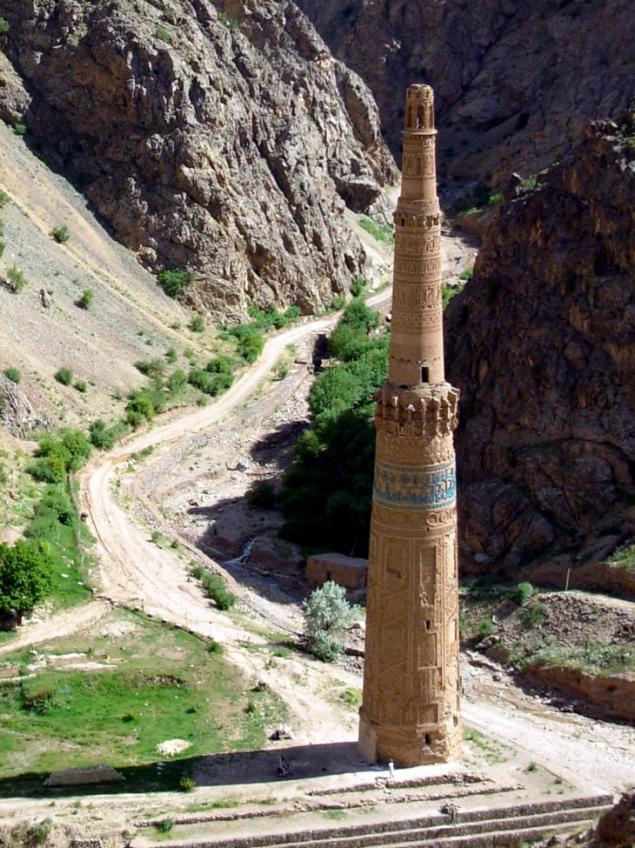
The height of the minaret - about 60 meters, according to one of the inscriptions on its walls, the structure was built in 1194, the year after winning the Sultan Giyaz al-Din's army ruler of Ghaznavid dynasty, but many experts are questioning the information. According to one version, the minaret - all that remains of the city Firuzkuh (which means "turquoise hill"), which in its heyday was the capital of the dynasty Gourde empire covering the territory of modern Iran, Pakistan, Afghanistan and India.
In the beginning of XIII-century Mongol Empire's armed forces under the command of the notorious Genghis Khan wiped the city to the ground, but they somehow overlooked the tall minaret
10. "The Emerald Tablet» h2> Unlike other archaeological phenomena compilation, "The Emerald Tablet" has not survived to our time, so that the scientists do not know who was the author of the original of the document for which it was intended and what fate befell the monument of medieval Eastern Art.
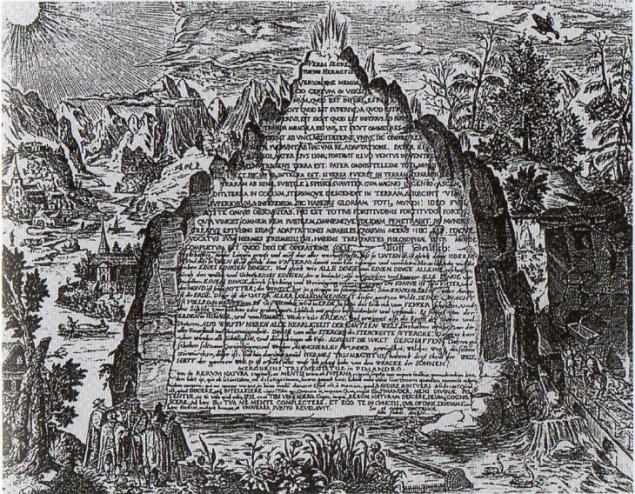
The only thing about the Emerald Tablet is for sure - what about it was first mentioned in the Arabic book, dated VI-th or VIII-th century AD. Some early copies of the "Tablet", made by Arab translators, there is evidence that the original was written in Syriac language, but evidence of this from the experts yet. The earliest Latin translations tablets dated XII-th centuries later created several versions of the text, the authorship of one of them belongs to the famous scientist, Sir Isaac Newton.
According to some scholars, in the "Emerald Tablet" describes the technology of conversion of various metals into gold with the help of a mythical substance, known as the Philosopher's Stone, but so far nobody has been able to conduct this alchemical experience - probably Latin and Arabic translations of the original "instructions" not too accurate.
via www.publy.ru/post/12158
24 Amazing Photos Native American late 19th century
7 stunning paradoxes that put the brain into a dead end























